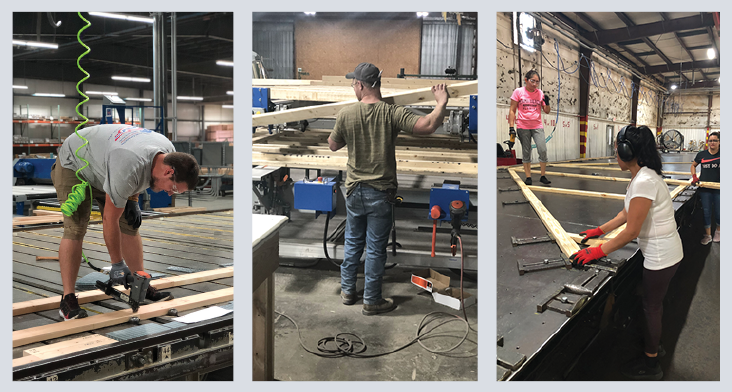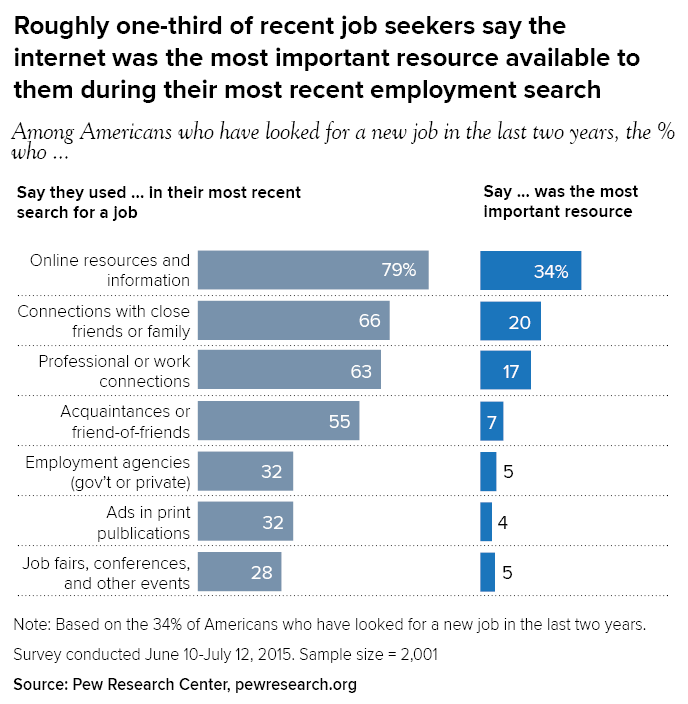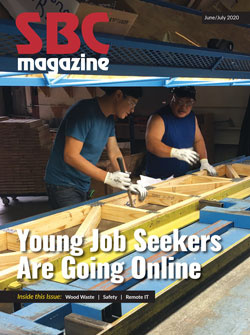Are You Missing Out on 79% of the Work Force?
Are You Missing Out on 79% of the Work Force?
As part of its strategic plan, the Structural Building Components Association (SBCA) has focused on five specific pain point areas that affect the industry, and tasked groups (called “Strike Forces”) to develop solutions in each of these areas. One of the Strike Forces is focused on gathering and refining best practices for attracting the quality employees our industry needs both now and in the future.

An SBCA member survey that helped identify these pain points revealed that 68 percent of CMs have a difficult time identifying, recruiting, and retaining staff. Of that group, 86 percent specifically had difficulty recruiting for their production team. Design staff followed close behind at 70 percent.
According to Pew Research Center, “Roughly one-third of Americans have looked for a new job in the last two years (2014-2015), and 79 percent of these job seekers utilized online resources in their most recent search for employment.” Their survey was taken in 2015, and it stands to reason that percentage has only increased since then. The Pew Research Center also reports that Millennials are now the largest generation in the workforce, accounting for roughly 35 percent. These two developments should encourage all components manufacturers (CMs) to post every job opening they have online as a general rule.

“If I am looking to research anything, the first thing I do is sit down in my La-Z-Boy at home and start Googling,” says millennial Brad Unruh, general manager of Timberlake Trussworks in Helena, Oklahoma. “What better way is there to find out information than from the comfort of home when there isnʼt the pressure of figuring it out in front of someone? My conclusions of what I think I want are generally created at home through Google searching before I ever leave the house.” Brad, also a member of SBCA’s Emerging Leaders Committee, says that 50 percent of his production team is made up of Millennials (and most of them applied online).
“People like using online job posting sites because they can gain all kinds of information,” says Justin Groom, another millennial, SBCA Emerging Leader, and general manager of TrussWorks North LLC in Caldwell, Texas. “They are able to view the job description, the average salary for that position, learn about the company culture, and apply for a job all in one place.”
Shawnee Gunnett, a structural estimator for Big C Lumber and another SBCA Emerging Leader, agrees, “Millennials are looking online, all the time. I don’t think that any of my friends are going to see a sign and personally walk into a company with a resume. They will see a sign, then go home and Google it to apply if it’s a career they’re interested in.”
This all suggests that the majority of the people you are looking to hire are missing out on your company’s job posting if it isn’t online. But what is the best approach? There are so many job posting sites out there. Which one will best suit your company’s needs? Here’s a breakdown of some of your best options.
Online Job Boards: Good for finding designers and production workers.
Across the board, Indeed is rated number one by review sites everywhere. With over 250 million job seekers and the fact that small businesses are able to utilize most of its free tools, Indeed could be an easy place to start. Indeed also allows past and present employees to leave reviews and list their salaries.
Pros: Employers can search for and message applicants through Indeed’s resume database system. Meaning, if you find a candidate that you believe would be a good fit, you can message them and ask them to apply. Indeed also offers customized screening questions to help filter through the multitude of applicants, helping to ensure quality candidates and a better retention rate.
It can be viewed both negatively and positively that past and current employees are able to leave anonymous reviews. Anonymous reviews can be frustrating because it’s difficult to ascertain how much value to place in comments from an anonymous source. While proponents argue the anonymity encourages greater honesty, it also puts a person who worked at the company for half a day on the same level as someone who has been with the company for several years.
The positive side is that your company has a chance to shine. There is also the opportunity to work on strengthening the company based on the more negative reviews by addressing the issues raised and responding to those reviews in a healthy way. The biggest pro about Indeed is that it is free for most small businesses. However, if your company is in a well-populated market, you should be prepared to pay to benefit from posting jobs on Indeed.
Cons: Being that Indeed is the largest job board site, some companies that use it have complained they receive too many unqualified applicants to filter through. Another down side of it being the biggest is that you are competing with every other employer out there. This means that when a candidate is searching for jobs they might have to scroll through 12 pages or more of postings before ever seeing your company’s opening. It will also likely increase the number of unqualified applicant submissions you will receive (see sidebar on page 15).
Pricing: While Indeed is free to small businesses, as mentioned above if you are targeting a well-populated area, Indeed will charge you per click. They do offer sponsored job posts starting at five dollars a day. This makes your post five times as likely to be clicked on. Due to the amount of companies using Indeed, you will be encouraged to pay for sponsored posts in order for those posts to be seen by potential candidates. They also offer a service called Hiring Campaign, which allows companies to work with consultants on a customized plan that includes sponsored job posts, advertising, etc. The pricing for the Hiring Campaign service varies depending on the company’s needs.
Others like Indeed: Monster, ZipRecruiter, CareerBuilder, Snagajob (for hourly positions only, which could make it a great tool for hiring production workers)
Company Review Sites: Good for finding designers and production workers.
Even if you don’t end up relying on this type of job posting site, you need to know about it because it will affect your company, if it hasn’t already. Have you ever wanted open and honest feedback about how your employees feel about every aspect of your company? Well, Glassdoor is going to give it to the world, whether you want them to or not. Glassdoor is the equivalent to Yelp, allowing more detailed reviews than you can leave on Indeed, and is a job seekerʼs paradise. It allows anyone to see and leave reviews of the company – including salaries, the interview process, ratings on company culture, work/life balance, benefits, CEO approval, etc. – and lets them apply if they like what they see.
One thing to note is the entire process, except for applying, is anonymous. This can be good or bad for an employer, depending on what their reviews say. There is no way for a company to stop people from leaving comments, but there is a way to go about proactively dealing with sites like these to ensure your company has a good online reputation. The most important thing you can do is ask current employees to regularly leave reviews. Once a year, or every other quarter, is a good place to start. This will ensure that your company has reviews left by actual employees who, hopefully, like being employed at your company. This will help raise your overall rating in the event an occasional negative review is posted. The second thing to keep in mind is that you can (and probably should) respond to both negative and positive reviews. It’s a good best practice in online rating systems to address the problem head on, let the reviewer know that you are sorry for their negative experience, and invite them to contact you directly so you can improve for the future.
Pros: According to the U.S. Chamber of Commerce, Glassdoor job seekers have a 30 percent higher retention rate compared to other job posting sites. The candidate that is applying to your company through Glassdoor has a pretty good idea of what to expect if they are hired due to all the transparency Glassdoor provides. If you have a good Glassdoor rating, quality candidates will want to apply. The best way to achieve a good rating is to look at all of the bad reviews and work on addressing the issues they raise. It is important to note that you can reply to the reviews for free. Keep in mind that review sites have been around for a long time. Yelp and Amazon, are great examples. These sites allow and even encourage people to leave reviews. Most people who use these review sites understand that someone out there is always going to find something to complain about. A few bad reviews won’t deter people from buying your products, eating at your restaurant or applying to your company. The key is to have plenty of good reviews to outweigh the negative ones. Restaurants achieve this by asking happy customers to leave them a quick review. Component manufacturers can ask their happy employees to do the same.
Cons: The obvious con with Glassdoor is that you cannot control what is posted about your company. You do not have to open an account for people to be able to leave reviews. If you haven’t looked your company up on Glassdoor, it’s a good idea to do so. Pretending review sites don’t exist will only hurt your company’s reputation. Be proactive!
Pricing: This website does have a free trial, but once that ends you will be charged between $199-699 depending on what tools fit your business the best. It is free to respond to reviews.
Social Media Job Board: Good for finding designers and production workers.
Out of all the social media sites, LinkedIn seems to be the front runner for attracting quality candidates. Posting jobs on social media sites allows you more exposure than some of the other options. Pew Research Center conducted a survey in 2019 that showed 72 percent of American adults have a social media profile. That means you are reaching about the same amount of people as you would through Indeed.
Pros: LinkedIn gives you access to a larger and better qualified crowd than other social media sites. How is this possible? You are capturing both active job seekers and passive ones. Most people use LinkedIn as a way to build their professional network and learn about topics related to their profession through reading articles and posts. That being said, LinkedIn has a tab called “Jobs” that is always on the userʼs screen. This entices people to passively check out new job opportunities. As a consequence, LinkedIn is geared more toward designers and office staff who regularly use a computer. LinkedIn also provides an option called Easy Apply. This allows candidates to apply to a job by uploading their application and information from LinkedIn. It takes about five minutes to use Easy Apply, whereas most sites would take you 30-60 minutes to apply for one job. This makes LinkedIn one of the top ways to apply for a job because everyone likes doing things efficiently, right?
Another pro for LinkedIn is that each candidate that applies for a job has a profile that you can review. This will allow you to get to know potential candidates a little more than just looking at their resumes.
Cons: LinkedIn may not reach production workers currently. However, this is most likely changing as we speak. Generation Z is starting to enter the work force. Most of this generation grew up with technology at their fingertips no matter what demographic they come from.
Pricing: LinkedIn charges you per click. This means you want to make sure you take the time to make the job description appealing so people want to apply once they have clicked on your job posting. It is important to note that you can set a budget. Once you have had a certain amount of clicks and you have reached your budget the posting will be removed until the next month. You are also able to take a job posting down at any time. LinkedIn also provides options to promote your job opening, which pushes it toward the top of the list.
Other options: Posting jobs on Facebook is a good option when looking for production workers. Pew Research Center’s 2019 survey reveals that 70 percent of Americans have a Facebook account. Ask your current production employees to share the job posting and this will increase your chances of success.
Another great resource to keep in mind is the Career Opportunities page on the Best Way to Frame website, which is a free resource to CM members for posting jobs (see sidebar on page 15).
With all of the facts and reviews in mind, we know that CMs are missing out on 79 percent of the job seeking population if they are not posting their jobs online. That said, it is imperative that our industry, an industry struggling for employees, utilizes the resources available to gain access to that 79 percent.
The Bottom Line
While there are many options out there for posting job openings online, it is important to find one or two that fit your company and the different positions available. Facebook, Snagajob, and Indeed are all great options when looking for production employees, whereas LinkedIn may be better for finding designers. All companies should keep an eye on Glassdoor. A company’s online reputation is becoming more important with each generation that enters the workforce; each generation being more tech savvy than the generation that precedes them. In this article we are just scraping the surface.
The key is for CMs to take action! Make a plan! Get with your HR team today and ask them if your company is utilizing job posting sites to their greatest extent. If the answer is “no,” or “we have in the past, but it didn’t work,” find a better game plan. Refine your process. A very wise man named Wayne Gretzky said, “You miss 100 percent of the shots you don’t take.” In this instance Wayne is telling you that your company is missing out on 79 percent of the job seeking population. Take a shot and post your job openings online.
Tips on Handling the Influx of Online Applications
Be aware that posting a job opening online is most likely going to bring in more applications than you would get through a classified ad in a local newspaper or through word of mouth. Scott Ward with Southern Components agrees, “When we put an ad in the local paper or post a sign out front we get five to ten applications. When we list a job online we get closer to 100. This can be extremely overwhelming since you still have to spend time looking at each applicant.”
One thing that can be done to help sift through the multitude of applicants is to have a two-step application process. The first step is filling out the application online and sending in the resume. Once an applicant has completed this first step, they immediately receive a follow up email asking them to take a personality or cognitive test to assess their potential fit with the company’s culture and likelihood for success in the position they are applying for.
This approach is fairly common for retail jobs and restaurants. Administering these test before you look at the applications will help you in multiple ways. Brad Unruh, general manager of Timberlake TrussWorks, takes this approach and says, “We find it not only weeds out anyone who is not truly serious about their application, the test scores also give us additional information about the candidate that we use to determine whether they are well suited for the position and our company.”
Good examples of tests used by component manufacturers today include:
- SBCA’s Technical Assessment Test Online (TATO)
- SBCA’s Truss Technician Training (TTT)
- Predictive Index
- Wonderlic Test
bestwaytoframe.com
Another great tool that SBCA members can utilize is the Career Opportunities page on SBCA’s Best Way to Frame website. CM members can log in at sbcindustry.com/careers to post open job positions that are then displayed at bestwaytoframe.com/career-opportunities for all to see.
Ron Moles, CEO of Walnut Custom Components, LLC in Walnut, Illinois, points out that it’s a unique opportunity to list a job somewhere that is industry specific. “Since the portal is specific to our industry it focuses on what both an employer and potential candidate are looking for. This should result in being able to identify and hire a higher quality employee.”
Post your open positions at
sbcindustry.com/careers today!




